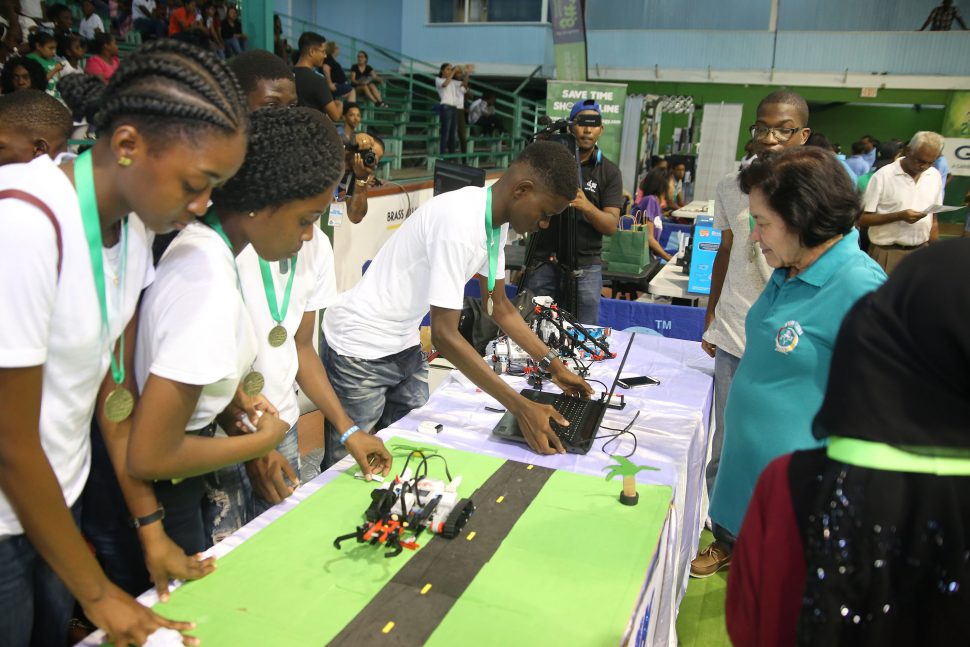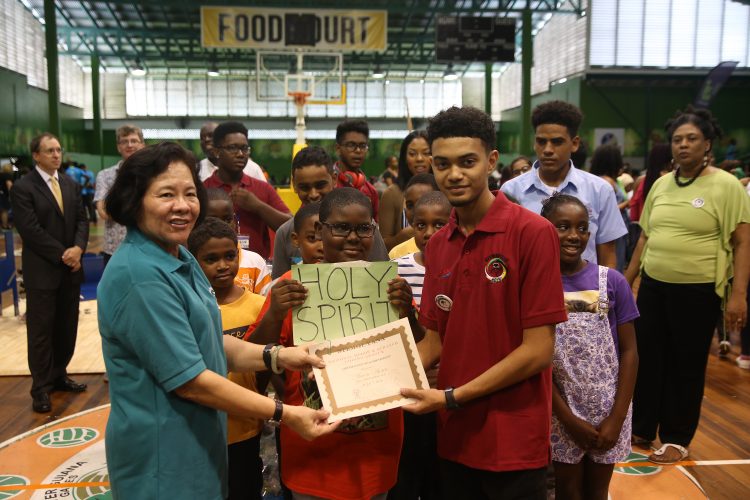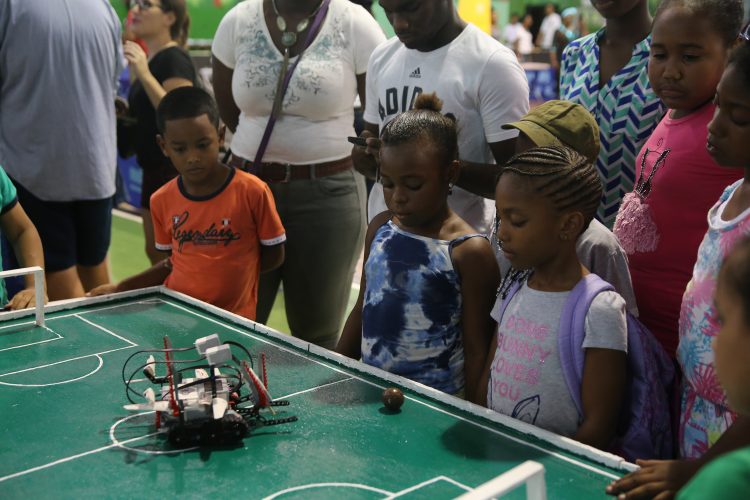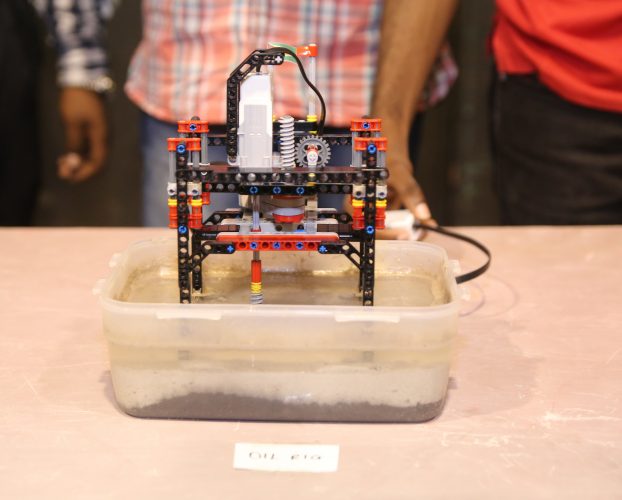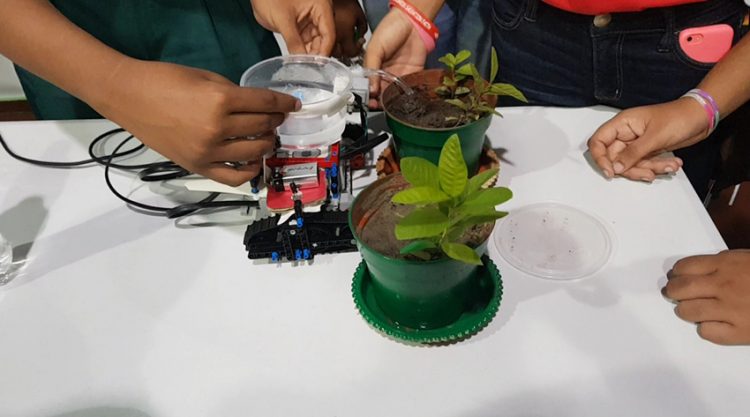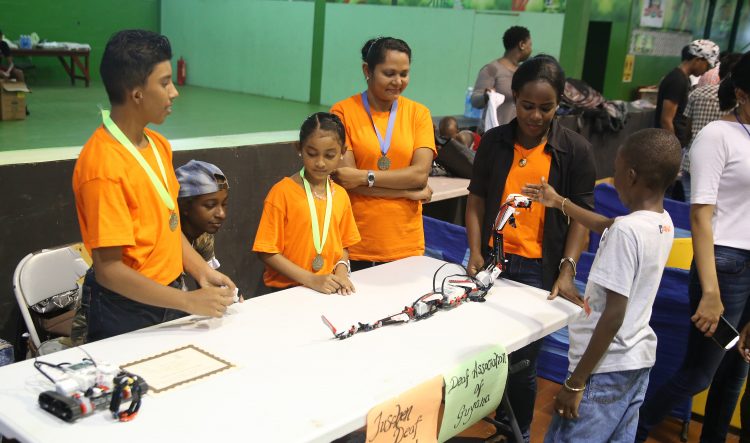The use of robotics as solutions to community-based challenges was on full display yesterday as hundreds attended the second annual National Robot Exhibition.
Organized and executed by the STEMGuyana Initiative (STEM stands for Science, Technology, Engineering and Math), the exhibition was staged at the Cliff Anderson Sports Hall on Home-stretch Avenue, Georgetown, and featured more than a dozen teams representing five of the country’s Ten Administrative Regions.
A quick stroll around the sports complex revealed robots designed as solutions to challenges, such as garbage collection and disposal, and crop irrigation, as well as others modeled off of oil rigs and even animals.
Garbage collection and disposal was the theme for the robots modeled by both the Three Miles Secondary School STEMClub, located in Bartica, and the Belladrum STEM Club from Region Five.
According to Leah Perreira, of Three Miles Secondary School, their robot was designed to collect garbage and dispose of it in an environmentally-friendly way, while at the same time taking into consideration Bartica’s hilly terrain.
“In Bartica, there are a lot of hills and bumps in the roads so we designed our robot to adapt to that so it can move easily without any destruction to the environment,” Perreira told Sunday Stabroek.
She also took the opportunity to share her views on the incorporation of a STEM Club at the school, saying while the club was only recently established, there has been a lot of excitement and fun in “getting the job done.”
“We were sponsored kits by the Office of Climate Change and we found that being a part of these clubs has been very beneficial because when you learn to build and programme these robots, you cannot only build and programme robots here or participate in competitions here, but you can go further. Its exposure to the world; Guyana and its people have capabilities of building robots,” she said.
Meanwhile, the team from the Belladrum STEM Club designed its bot to identify and separate recyclable and non-recyclable waste. The design and construction of the robot took them between two to three weeks, one team member shared.
In another corner of the room was the STEM club of the St. Rose’s High School, which showcased a robot designed to carry out the task of watering crops.
Kevin Deonarine, an Eighth Grade student of the school and member of the STEM Club, explained that the robot starts off by using a sensor to identify the green parts of the plant, after which it activates a switch controlling a motor that uses water stored in the tank to water the plant.
“The name of the robot is Aquabot because it deals with water and after 20 to 15 seconds, [when] it detects that the plant has enough water, the circuit will break and either go on to water a next plant has enough water, the circuit will break and either go on to water a next plant or back to the storage area,” Deonarine explained.
Sunday Stabroek was told that the team took two weeks to come up with the concept and while the base of the robot came from the robotics kit, other materials from around the home and school were recycled and incorporated into the finished product.
Taking a different route, the Kuru Kururu Informatics STEM Club opted to design a replica of one of ExxonMobil’s oil rigs.
“We got the inspiration to build this from the ExxonMobil project; we have one motor that raises the platform up and down to lower the drill in new depths and then we have another motor that works the actual drill to find the oil. This particular one took us three days to build because we didn’t have any manual to work off of; we had to build it completely off our heads. It still has a few bugs on it but we are going to work on those a bit later. It is something that is current in the country right now and it was a fun challenge,” Timothy Melville, a member of the club shared.
Another interesting design was one showcased by the Tuschen Deaf Academy team, who used resources from the internet to build their own “snapping raptor.”
Team member Asiyah Ghani, using sign language and help from a translator, told Sunday Stabroek that they learnt how to build and programme the bot, which can be controlled via Bluetooth, from resources found on the internet.
Meanwhile, Founder of STEMGuyana, Karen Abrams, in an invited comment, said this year’s event surpassed last year’s, particularly since they would have not only seen teams from several regions participating, but the initiative also benefitted from more community support.
“This year was definitely better than last year; we had more people, we’ve got more teams, there is more energy. I think the word is getting out and it’s awesome. We have got 18 teams participating in the Pilot League and we have had a few others from last year coming out today. We had a lot of community support as well even though the rain is falling this is really awesome and we really believe that the knowledge is catching on because these Guyanese here today represent five regions of Guyana. We have people from Crabwood Creek, Belladrum, Bartica, Linden and Region Four,” she shared.
“We have people from all over the place and they all recognize the benefits and so we have learnt a lot of lessons from this year and we are going to fix what needs to be fixed and move into next year’s event with the hope of having at least 100 teams,” Abrams added.
Commenting on the exhibits on display yesterday, the Founder said, “These guys came up with ideas based on what they saw in their own community and that’s exactly what we want to have happen. There is a garbage situation in many regions and these guys use these robots to address it. Now, imagine 10 years from now when they are adults and they really look around to see that they have power and access to finances, they can make good decisions that impact their community and that is what we want.”
“What we want is not to just teach people robotics, we want to help to strengthen their communication, cooperation, problem solving, critical thinking, all of which you need to be a good, proactive citizen to solve problems in your community, in the region, and in the world. It’s not only STEM students we want to help to create, we want to create good citizens of Guyana,” she posited.
